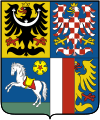Moravian–Silesian Region
|
Moravian-Silesian Region Moravskoslezský kraj |
|||
|---|---|---|---|
| Region | |||

Undermined church in Karviná
|
|||
|
|||
 |
|||
| Coordinates: 49°47′N 18°02′E / 49.78°N 18.03°ECoordinates: 49°47′N 18°02′E / 49.78°N 18.03°E | |||
| Country | Czech Republic | ||
| Capital | Ostrava | ||
| Government | |||
| • Governor | Ivo Vondrák | ||
| Area | |||
| • Total | 5,426.83 km2 (2,095.31 sq mi) | ||
| Highest elevation | 1,491 m (4,892 ft) | ||
| Population (01/2016)[1] | |||
| • Total | 1,213,311 | ||
| • Density | 220/km2 (580/sq mi) | ||
| Time zone | CET (UTC+1) | ||
| • Summer (DST) | CEST (UTC+2) | ||
| ISO 3166-2 | CZ-MO | ||
| Licence plate | T | ||
| NUTS code | CZ08 | ||
| GDP per capita (PPS) | € 15,300 | ||
| Website | www.msk.cz | ||
The Moravian-Silesian Region (Czech: Moravskoslezský kraj; Polish: Kraj morawsko-śląski; Slovak: Moravsko-sliezsky kraj), is one of the 14 administrative Regions of the Czech Republic. Before May 2001 it was called the Ostrava Region (Czech: Ostravský kraj). The region is located in the north-eastern part of its historical region of Moravia and in most of the Czech part of the historical region of Silesia. The region borders the Olomouc Region to the west and the Zlín Region to the south. It also borders two other countries – Poland (Opole and Silesian Voivodeships) to the north and Slovakia (Žilina Region) to the east.
Once a highly industrialized region, it was called the "Steel Heart of the Country" in the communist era. There are, in addition, several mountainous areas where the landscape is relatively preserved. Nowadays, the economy of the region benefits from its location in the Czech/Polish/Slovak borderlands.
The geography of the region varies considerably, comprising many landforms from lowlands to high mountains whose summits lie above the tree line.
In the west lie the Hrubý Jeseník mountains, with the highest mountain of the region, and all Moravia), Praděd, rising 1,491 metres (4,892 ft). The mountains are heavily forested, with many spectacular places and famous spas such as Karlova Studánka and Jeseník and are therefore very popular with tourists. There are also several ski resorts, including Červenohorské Sedlo and Ovčárna, with long-lasting snow cover. The Hrubý Jeseník mountains slowly merge into the rolling hills of the Nízký Jeseníks and Oderské Vrchy, rising to 800 m at Slunečná and 680 m at Fidlův Kopec respectively.
...
Wikipedia


